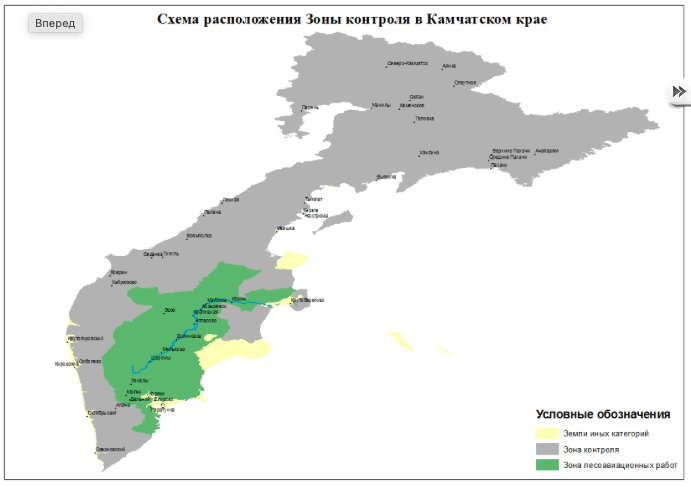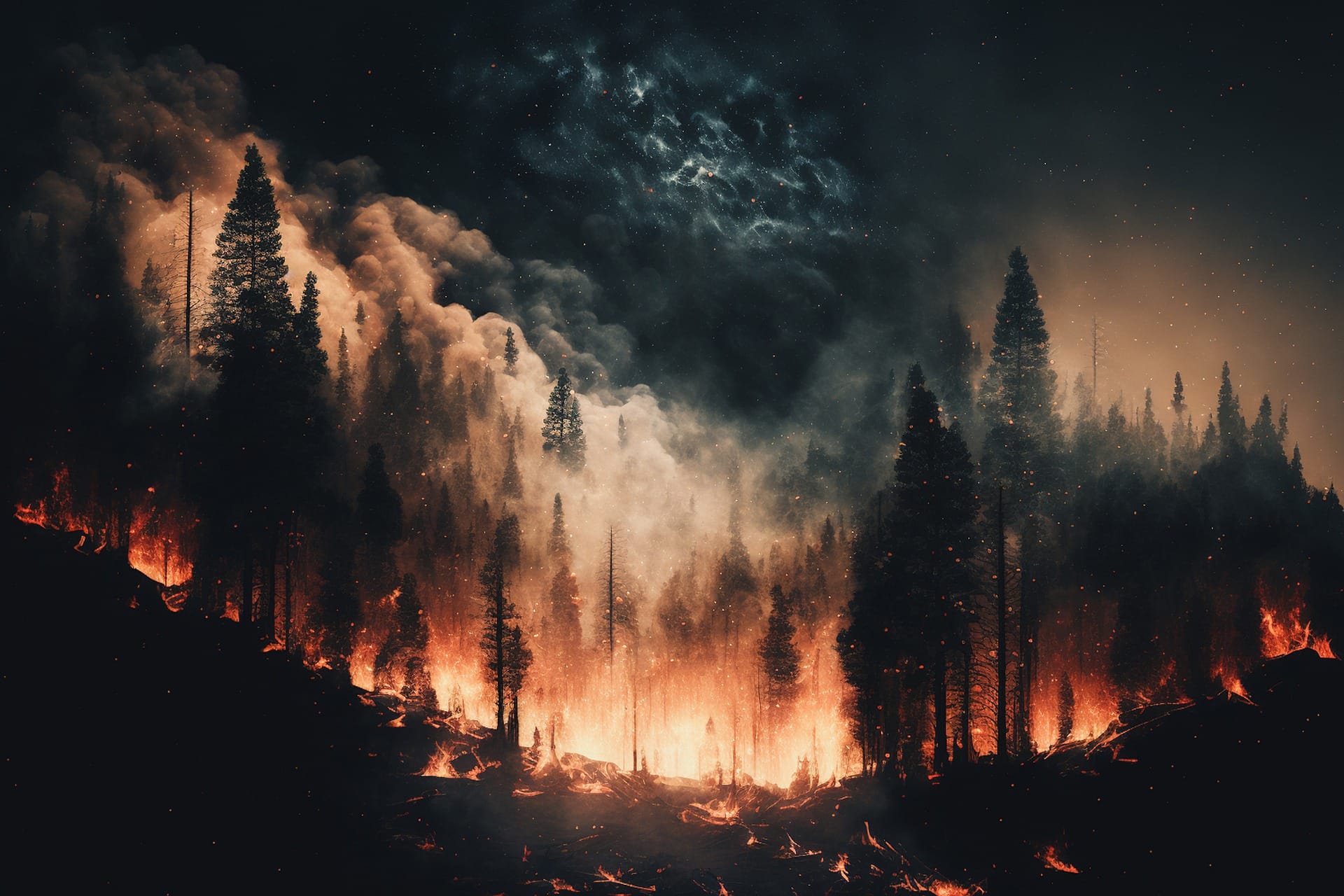Forest fires are a regular problem for many countries, including Russia. We decided to check some popular myths about forest fires.
More recently, at the beginning of May 2023, fires in the Kurgan region carried away the lives of 21 people and left more than one hundred residents homeless. And just last year in Russia the fire affected 34,000 km2, which is comparable to the territory of such states as Belgium or Armenia. In Europe, the problem of fires is also acute: there in 2022 burned out an area comparable in size to Montenegro. Specialists are afraidthat 2023 could be even worse. According to the World Wildlife Fund* (WWF) for 2000–2016, on average there are forest fires every year in the world covered territory of 3.4 million km2, that is, more than the whole area India.
Contents of the article
- Most forest fires occur due to natural causes
- Using aviation is the most effective way to fight forest fires
- Burning dry grass in the spring and selectively cutting down trees helps prevent fires
- Forests are set on fire to hide illegal logging
- Forest fires occur due to the spontaneous combustion of peat, which can burn at a depth of many meters
- Not all fires need to be put out
Most forest fires occur due to natural causes
Quite often natural phenomena are blamed for fires. For example, in the fires of 2022 in the Ryazan region, local authorities “accused» a dry thunderstorm, that is, lightning, after the strike of which there was either no rain at all, or it was insignificant. Greenpeace experts doubted this version, since “no thunderstorms or other natural phenomena were recorded in the area,” and done the conclusion is that people are most likely to blame.
There are only three natural or natural reasons why a fire can occur: a volcanic eruption, a meteorite fall and a dry thunderstorm. If we talk about central Russia and Siberia, no eruptions few There have been no volcanoes there in recent years, and there is also no data on meteorite falls that led to any extensive fires. But thunderstorms in these regions occur quite often, but several factors must come together for a fire to occur. Volunteer movement “Volunteer Forest Firefighters” describes such a situation: “Lightning strikes a high-standing tree on a mountain or hill, and after that either no rain occurs (due to the earth being strongly heated by hot weather, the rain evaporates before reaching it), or the rain is very light. The fire travels down the tree, goes to the roots and after a few hours or days can develop into a fire. Such cases are most specific to places where there are no people.” By data According to the Federal Forestry Agency of the Russian Federation (Rosleskhoz), in different years only 10% to 27% of fires occurred due to dry thunderstorms. In turn, Greenpeace believesthat 90% of forest fires in Russia are caused by humans. Similar data in the USA: according to statistics According to the Insurance Information Institute, 85% of forest fires are caused by human actions.
However, hot weather itself cannot cause a fire. In order for the grass to catch fire from unfocused sunlight, required heating the surface to at least 300 °C. If the Sun heated our planet to such temperatures, then forest fires would be humanity's last problem. At the same time, dry grass really catches fire extremely easily - an unextinguished cigarette is enough for this to happen (smoldering cigarette has temperature 300–420 °C).
Thus, both Russian and foreign experts agree that the majority of fires are anthropogenic, that is, caused by human actions rather than natural phenomena.
Not true
Using aviation is the most effective way to fight forest fires
Personnel with planes flying into clouds of smoke from a fire and dropping thousands of liters of water on it, look extremely impressive. From a household point of view, such extinguishing seems effective, because responsible tourists also made a fire in the forest poured water. Information that for this or that fire arrived aviation, often share The media, creating in the audience the feeling that now the fire will definitely be extinguished.

Air extinguishing occurs according to the following algorithm: the plane takes on water, and then, upon reaching the fire site, pours it onto the burning forest. However, most often it is almost impossible to fly exactly to the edge of the fire so that the water gets to the right place and delays the fire. To ensure maximum accuracy of the drop, the aircraft must fly at an extremely low altitude, and in most cases this is hampered by smoke and turbulence caused by rising currents of hot air. Fighting fires with the help of aviation is a more financially expensive action than fighting fires from the ground, which can also be joined by volunteers.
Grigory Kuksin, head of the fire safety project of the Russian branch of Greenpeace, lists disadvantages of fighting fires using aviation. Firstly, the plane is capable of flooding only a small area of the edge of the fire with water - “a drop from a helicopter is enough to extinguish approximately 30–70 m, a drop from a Be-200ChS - about 350 m, and from an Il-76 - 750 m,” that is, we are not talking about completely eliminating the fire in this area, but only about extinguishing, that is, slowing down the spread of the fire.
Secondly, the area of use of such aircraft is significantly limited - there must be a sufficiently large, deep and clean body of water nearby from which water can be taken for extinguishing. While this method of fighting fires is effective in Chile or Portugal, which stretch along the sea coast, then, for example, in many regions of Russia it is simply impossible to resort to it. Moreover, some models (for example, the modernized Il-76 transport aircraft) are completely incapable of refueling from the surface of the sea or lake, and water is brought to them at the airfield. So sending Russian aviation (even during the fire season in the Russian Federation) to other countries (Greece, Italy, Portugal, Croatia, Montenegro or Turkey) is not a beautiful gesture of international cooperation, but a justified action. To work on fires in Central Russia and Siberia, it would be more appropriate to use helicopters and small aircraft - Cessnas, Robinsons and An-2 (popularly called a “corner”), which would transport people to the necessary locations, and also ensure the delivery of water for ground extinguishing.
Thirdly, it is extremely difficult to coordinate the work of those fighting from the ground and aviation. Water discharge can be carried out only after ground services have been withdrawn to a safe distance, and taking into account the fact that bodies of water suitable for water intake can be located quite far away, several hours pass before the next arrival of the aircraft. That is, ground services will spend more time retreating and returning to the firefighting zone than fighting the fire itself. Kuksin says that in Russia, aviation “is more of a means of calming people down than of putting out fires. People expect a spectacular picture and get it. And foresters work quietly on the ground, ensuring real success in extinguishing.”
Thus, aviation can really help people fight fires in coastal areas or around large rivers and lakes. To extinguish forest fires in central Russia and Siberia, specialized aircraft often cannot use their full capabilities, so in these regions it is more appropriate to extinguish fires from the ground.
Half-truth
Burning dry grass in the spring and selectively cutting down trees helps prevent fires
Spring burning of dry grass, also known as burning, is common way conducting both private and urban. And although Rosleskhoz categorically does not recommend resorting to such measures, in 2023 this practice will be abandoned didn't refuse authorities of Omsk, Kemerovo and Lipetsk regions, as well as Adygea and Tatarstan. Preventative felling also called one of the ways to prevent fires. Both approaches are based on the controlled destruction of as much potential “fuel” as possible, thanks to which a fire can cover large areas.
Let's first deal with spring fires. Besides the fact that the smoke coming from them worsens ecology of cities and villages, and local residents more often suffer from respiratory problems, experts agree that the practice itself is not only useless for fighting fires, but also harmful. And although visually, after setting fire to last year’s grass, it may seem that fresh grass has sprouted faster, this is an optical illusion - there are simply young green shoots on the black ground more noticeablethan if they were growing through a layer of last year's foliage.

Ash resulting from a fire does not fertilize the soil. On the contrary, according to words Candidate of Agricultural Sciences Anatoly Nakoryakov, the annual “burning of grass and shrubs impoverishes the soil and deteriorates its structure - after three to five years it degrades and becomes less fertile.” The volunteer movement “Volunteer Forest Firefighters” also draws Please note that during preventive burning, clutches and nesting sites of birds, newborn hares, hedgehogs and hedgehogs, toads, frogs, many insects, their larvae, pupae, as well as earthworms can burn. All this negatively affects the environmental situation.
Head of the forestry department of the Russian branch of Greenpeace Alexey Yaroshenko leads the following data: “The Amur region has refused mass professional burning. As a result, 2019 and 2020 turned out to be relatively calm for the Amur region, just like 2021.” This confirm and the regional authorities - according to the governor of the Amur region Vasily Orlov, in 2018, 2.3 million hectares of forest burned there, in 2019 - 271,000 hectares, in 2020 - 172,000 hectares. Among the main reasons for positive changes in this area, the official named the refusal of fires.
Selective logging doesn't seem to work either. Firstly, it leaves behind stumps and branches, which, when dried, become flammable fuel. After analyzing 1,500 forest fires that occurred in the western United States from 1984 to 2014, American scientists came to the conclusion that those areas where the level of forest management was higher suffered more, that is, preventive logging was carried out. Secondly, supporters of this practice believe that it contributes to the conservation of rare species of animals and birds by saving their habitat from fire, but scientific data this do not confirm. Animals and birds, on the contrary, extract benefit from the burnt forest - for example, in such conditions it is easier for predators to find food for themselves.
Thus, there is no significant benefit from preventive spring fires or cutting down trees in hazardous areas. Burning dry grass in the spring will more likely lead to a fire than prevent it, and at the same time destroy the ecosystem. Felling is also ineffective, because larger fires usually result in such areas.

Not true
Forests are set on fire to hide illegal logging
"Black Lumberjacks" along with "black transplantologists» are regularly in the news: the media report on their activities in Buryatia, Krasnodar region, Kemerovo, Irkutsk, Novosibirsk, Omsk And Tomsk areas. It is believed that they can mask their crimes with forest fires.
Those who carry out illegal logging are popularly called “black loggers.” However, according to environmentalists, their role in forest destruction is insignificant - Alexey Yaroshenko from Greenpeace evaluates damage is 10% of the total destruction of forests. Most of the fellings from which forests suffer cannot be definitely called “black”; most often their organizers have some kind of permits, so it would be more correct to consider these people “gray loggers.” For example, it is indicative story Deputy of the Legislative Assembly of the Irkutsk Region Evgeny Bakurov. British NGO Earthsight in 2021 found outthat the politician cut down healthy trees, passing them off as sick, and sold the wood to IKEA. According to investigators, 4 million trees (almost 15,000 hectares) fell under the ax, and thanks to this, the deputy earned RUB 18.5 billion Earthsight determined that this illegally harvested wood was most likely used by IKEA to produce its popular Sundvik children's line, including chairs, tables, beds and wardrobes, as well as the Flisat dollhouse. According to the calculations of the British organization, every two minutes a product of the famous Swedish company, made from Russian materials of “dubious” origin, was purchased in the world.

The second most popular “gray” scheme describes WWF expert Nikita Debkov: “Suppose a plot of land is being rented out where, according to documents, there are 200 cubic meters of birch per hectare. But these are old measurements: over time, the forest has grown, and in fact there are 300 cubic meters per hectare. As a result, unaccounted forage is formed, which is safely cut down and taken away. According to our data, of the total volume of sawn timber in Russia, approximately 20–30% is unaccounted for.”
Greenpeace agree with the fact that the main problem is not illegal logging: in 2021, “the majority of new fires that can still be determined where and how they started occurred in [legal] logging.” Experts believe that the main problem is a violation of logging techniques, when workers do not remove the so-called “logging residues” - chips, branches and small pieces of trees, but burn them on the spot.
Moreover, the fire will not hide the deforestation, because instead of charred and fallen trees, charred stumps will remain at the site of the fire. For example, this is what a forest in Siberia that burned in 2021 looks like after the fire was extinguished.

And here is the burnt forest around Lake Baikal.

Thus, “black loggers” are not the biggest danger to forests and not the main cause of fires. Firstly, no fire, in principle, can hide deforestation; photographs of forests after real fires clearly show preserved tree trunks, and not stumps in their place. Secondly, there are not so many illegal logging sites that would need to be hidden in this way. Most of their organizers officially register the deforestation, while passing off a healthy forest as a diseased one or downplaying the real number of trees in the area of interest.

Not true
Forest fires occur due to the spontaneous combustion of peat, which can burn at a depth of many meters
They write about the possible spontaneous combustion of peat RIA Novosti And "Belarus satellite», and regional portals in different years called its cause of forest fires in Cherepovets, Miass, Chuvashia And Irkutsk region. It is also believed that peat can form large, deep burning channels - for example, there are popular stories about how some people fell into such a channel to a depth of up to 50 m.
Let's start with the fact that 50 m is an absolutely prohibitive figure (for comparison, height nine-story buildings - about 30 m). Average the depth of the peat fire, according to Avialesookhrana, amounts to 1.5 m. Deeper than this mark is already can groundwater is located, so pockets more than 2 m deep can only be where untapped peat accumulations are stored or where railway embankments made from it pass through. At the same time, peat is really capable burn out from the inside, forming voids (experts call them burnouts) into which both people and equipment can fall.

Formally, peat can actually combust spontaneously, note forest fire specialists. To do this, it must already be extracted from the ground, crushed, folded in a special way into caravans or piles (as briquettes for transportation are called), and then, when wet, equal to 35%, placed in the sun. In reality, this situation is now extremely unlikely - already in Soviet times, for which had to peak of the development of the peat mining industry, a control system appeared over the places where these caravans were stored. In the 1980s, gas became the main fuel and peat extraction plants began to close. By data organization "Volunteer Forest Firefighters of the Central Region", most of the previously packed caravans have already been removed or burned down. Therefore, today the main cause peat fires are again human actions, for example, throwing away unextinguished cigarettes or spring fires.
A peat fire is dangerous not only because someone can fall through the fire, but also because it Maybe cause a forest fire, as well as hide underground and survive the winter there, continuing their destructive activities. It was the burning peatlands that caused the smoke in Moscow and the Moscow region in 2010. By estimates specialists, then due to smog and heat, mortality increased by 36% (more than 10,000 excess deaths), and thousands of animals and birds also died.
Thus, spontaneous combustion of peat can indeed happen, but in nature many conditions must exist for this to happen: peat must be extracted, crushed, placed in caravans and placed under sunlight at a certain humidity. Almost all peat fires in recent years are caused by humans. Stories about people or equipment sinking many meters underground due to burnt-out peat, although based on actual burnouts, are usually greatly exaggerated.
Mostly not true
Not all fires need to be put out
Often, officials, making excuses for insufficiently fighting large-scale fires, mentionthat they started in areas where extinguishing is not necessary, and they also claim that the fires are natural natural phenomenon. So, for example, in 2019 spoke out Governor of the Krasnoyarsk Territory Alexander Uss: “If we have cold weather in winter and a snowstorm occurs, no one thinks of drowning icebergs to make it warmer. <…> It’s not just about the government, the point is that this is a common natural phenomenon, which is pointless to fight, and maybe even harmful in some places.” From their words one may get the impression that only those fires that directly threaten people need to be extinguished.
In 2015, in the Russian legislation introduced concept control zones - areas where forest fires are allowed not to be extinguished "in the absence of a threat to populated areas or economic facilities in cases where the projected costs of extinguishing a forest fire exceed the projected harm that can be caused to them." Greenpeace reports, that “in practice, forest management authorities consider control zones as unprotected territories, within the boundaries of which fires can not only not be extinguished, but also not taken into account - at least in operational reports.” Approximately 45% of the entire forest fund of the Russian Federation belongs to such zones. But does this mean that there is really no need to put out such fires?
The very term “control zones” sounds as if officials have special control over fires in these areas, rather than allowing fires to burn uncontrollably. However, in practice, fires there most often occur uncontrollably in the sense that response services intervene only when settlements outside this zone begin to suffer from the fire. In particular, in 2022, smoke from fires in control zones in the Khabarovsk Territory covered Yakutsk Moreover, notes Grigory Kuksin from Greenpeace, there are territories where the control zone includes both populated areas and roads that are significant for the region. You can easily verify this yourself by studying the map of control zones from the official site “Avialesookhrana” and comparing it with Google maps.


Moreover, fires are not only a risk for those living in communities directly affected by the fire. As mentioned above, dense smog causes excess deaths in cities and villages located many kilometers from the fire site. In addition, a burning forest is a significant ejection greenhouse gases, which is largely responsible for global warming. A hot and dry climate, although it cannot cause a fire, promotes the spread of fires over even greater distances.
At the same time, in Russia, as note Greenpeace experts, so far there are neither budgetary funds nor technical capabilities to extinguish absolutely every forest fire. Ecologists propose to gradually reduce control zones and begin to extinguish at least those fires from which smoke can come to populated areas or that pose a threat to nature reserves and national parks. For comparison, in the USA don't extinguish only 0.4% of all fires that occur.
Thus, fires not only destroy forests, but also negatively affect the health of people, including those living at a considerable distance from the area engulfed in fire. Moreover, a forest fire is a source of greenhouse gases, which, in turn, stimulate global warming, which contributes to the faster and larger spread of fire in forests. Environmentalists agree that humanity should try to extinguish as many forest fires as possible, leaving less than 1% of forests free to burn. However, in Russia, the question “to extinguish or not to extinguish” is most often answered not from the position of concern for nature, but based on the volume of allocated budget funding.
Mostly not true
Cover image: Image by Chil Vera from Pixabay
*WWF is recognized by the Russian authorities as a foreign agent.
Read on the topic:
- Is it true that a plane completely burns out in 90 seconds?
- Is it true that some bird species start fires in Australia?
If you find a spelling or grammatical error, please let us know by highlighting the error text and clicking Ctrl+Enter.






